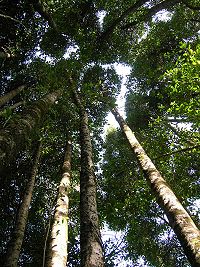
Photo from wikipedia
Abstract Planted forests are becoming increasingly common worldwide, replacing natural forests and compromising their associated biodiversity. However, not all forest plantations are the same. Aiming to identify key plantation features… Click to show full abstract
Abstract Planted forests are becoming increasingly common worldwide, replacing natural forests and compromising their associated biodiversity. However, not all forest plantations are the same. Aiming to identify key plantation features that could be managed to improve bird diversity, we conducted a meta-analysis examining the differential effects of several kinds of plantations on bird species richness and abundance. Our literature survey provided 123 case studies (68 cases for species richness and 55 for abundance), which showed that, although forest plantations have negative effects on both richness and abundance, there is a large heterogeneity of responses among plantation types. The least negative effects were found at plantations established with native tree species and mixed arrangements, along with those intended for protective uses. Moreover, exotic monocultures for commercial purposes were found to be the most negative plantations for bird diversity. Likewise, small (
Journal Title: Forest Ecology and Management
Year Published: 2019
Link to full text (if available)
Share on Social Media: Sign Up to like & get
recommendations!